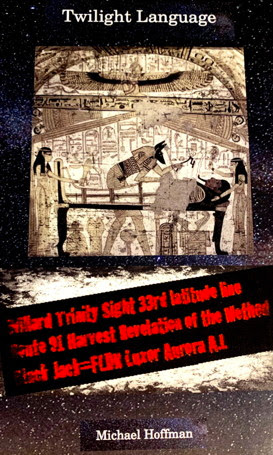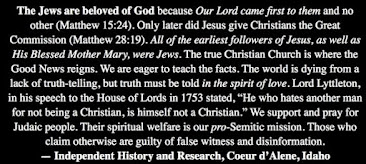Along with us, our colleague who blogs under the
nom de plume, “
Maurice Pinay” has offered ample documentation of the anti-Catholic weirdness, perversity and occultism that travels under the moniker, “traditional Catholicism.” Or, as our north Idaho cowboy pal Caleb would say, “Traditional Catholicism
ain’t.”
While one of those who Maurice targets as being among the
ain’t Catholics is Bp. Richard N. Williamson, nonetheless we do not shy away from employing the following research from Williamson to demonstrate how “sedevacantist Catholicism”
ain’t Catholic.
Sedevacantism, for those who don’t know the term, is a “traditional Catholic” faction that declares on its own non-existent authority, that certain “heretical” popes are not popes, and therefore are not owed the obedience due the pontiff. Sedevacantist priests and alleged bishops depose these popes by stating, “They are formal heretics, therefore they are not popes.” Luther said something like that, so here we have the bipolar manifestation of Lutheran-“traditional Catholicism.” It just gets crazier and goofier as these folks descend further down the ladder of their home-made religion which is situated somewhere between Catholicism, Protestantism and the Twilight Zone.
We don't accept that parish priests or questionably-consecrated “traditional Catholic bishops" have any power or authority whatsoever to declare — other than to their own conscience — that a pope is not a pope and can be disobeyed. The very notion smacks more of a proclamation by a backwoods assembly of the Four Square church, than by the One Holy Catholic and Apostolic Church.
The actual Catholic Church has a theology that teaches that no one can depose a pope — that the pope has no peer on earth. According to Catholic theology he is sovereign. Williamson describes the complex
Catholic process for removing a heretical pope. Patently, until the process Williamson outlines takes place, the pope elected by the College of Cardinals, whether Paul VI or Francis the one and only, is the pope of the Church of Rome until a
Church Council removes him. Bishop Williamson makes the following report,
after which we will add one further point.
Church Councils can heretical Popes untie,
For Christ to depose, lest the whole Church die.
The Dominican priests of Avrillé, France, have done us all a great favour by republishing the considerations on the vacant See of Rome written some 400 years ago by a famous thomist theologian from Spain, John of St Thomas (1589–1644). Being a faithful successor of St Thomas
Aquinas, he benefits from that higher wisdom of the Middle Ages when theologians could still measure men by God instead of having to measure God by men, a tendency which began as a necessity (if souls could no longer take medieval penicillin, they had to take a lesser medicine), but which culminated in Vatican II. Here, much abbreviated, are the main ideas of John of St Thomas on the deposition of a Pope:—
I Can a Pope be deposed?
Answer, yes, because Catholics are obliged to separate themselves from heretics, after the heretics have been warned (Titus III, 10). Also, a heretical Pope puts the whole Church in a state of legitimate self-defence. But the Pope must be warned first, as officially as possible, in case he would retract. Also his heresy must be public, and declared as officially as possible, to prevent wholesale confusion among Catholics, by their being bound to follow.
II By whom must he be officially declared a heretic?
Answer, not by the Cardinals because although they may elect a Pope, they cannot depose one, because it is the Universal Church that is threatened by a heretical Pope, and so the most universal possible authority of the Church can alone depose him, namely a Church Council composed of a quorum of all the Church’s Cardinals and Bishops. These would be convoked not authoritatively (which the Pope alone can do) but among themselves.
III By what authority would a Church Council depose the Pope?
(Here is the main difficulty because Christ gives to the Pope supreme power over the entire Church, with no exception, as Vatican I defined in 1870. Already John of St Thomas gave arguments of authority, reason and Canon Law to prove this supreme power of the Pope. Then how can a Council, being beneath the Pope, yet depose him? John of St Thomas adopts the solution laid out by another famous Dominican theologian, Thomas Cajetan (1469–1534). The Church’s deposition of the Pope would fall not upon the Pope as Pope, but upon the bond between the man and his Papacy. That may seem hair-splitting, but it is logical.)
On the one hand not even a Church Council has authority over the Pope. On the other hand the Church is obliged to avoid heretics and to protect the sheep. Therefore, just as in a Conclave the Cardinals are the ministers of Christ to bind this man to the Papacy, but Christ alone gives him his papal authority, so the Church Council would be the ministers of Christ to unbind this heretic from the Papacy by their solemn declaration, but Christ alone, by his divine authority over the Pope, would authoritatively depose him. In other words, the Church Council would be deposing the Pope not authoritatively from above, but only ministerially from below. John of St Thomas confirms this conclusion from the Church’s Canon Law, which states in several places that God alone can depose the Pope, but the Church can pass judgment on his heresy.
Alas, as the Dominicans of Avrillé point out, nearly all Cardinals and Bishops of the Church today are so largely infected with modernism that there is no human hope of a Church Council seeing clear to condemn the modernism of the Conciliar Popes. We can only pray and wait for the divine solution, which will come in God’s good time. To follow, is a Pope not automatically deposed by his mere heresy?
Additional point by Michael Hoffman: In reading St. Thomas More’s letter to England’s Lord Chancellor Thomas Cromwell, which More penned in Chelsea on March 5, 1534, we encountered this sentence: “…in the next general council it may well happen that this Pope may be deposed and another substituted in his room with whom the King’s Highness may be very well content.” (Alvaro De Silva [ed.]
The Last Letters of Thomas More [Eerdman’s Publishing, 2000], p. 54).
















